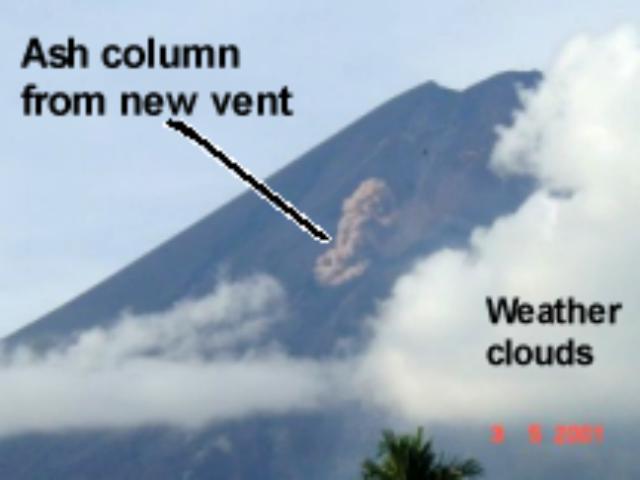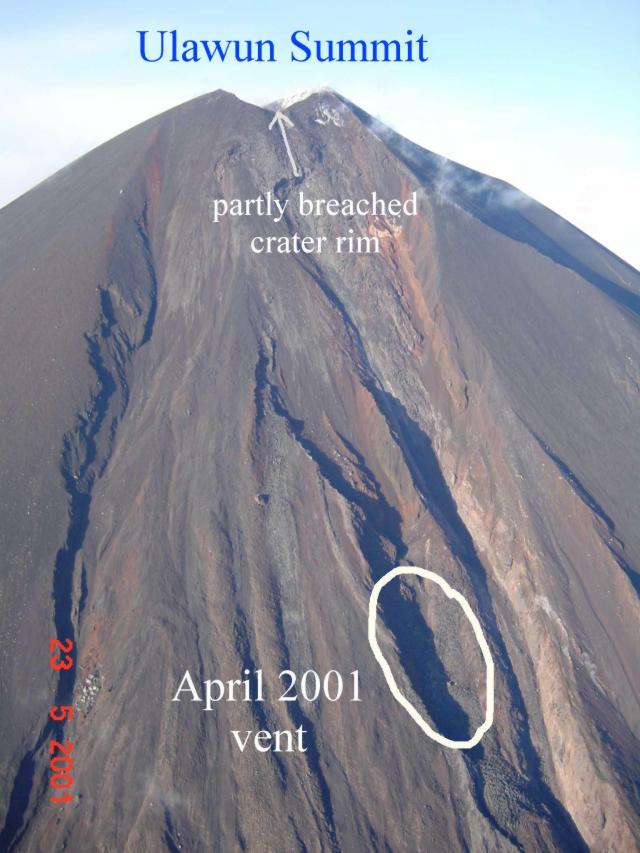Report on Ulawun (Papua New Guinea) — June 2001
Bulletin of the Global Volcanism Network, vol. 26, no. 6 (June 2001)
Managing Editor: Richard Wunderman.
Ulawun (Papua New Guinea) New vent opens during April-May eruption
Please cite this report as:
Global Volcanism Program, 2001. Report on Ulawun (Papua New Guinea) (Wunderman, R., ed.). Bulletin of the Global Volcanism Network, 26:6. Smithsonian Institution. https://doi.org/10.5479/si.GVP.BGVN200106-252120
Ulawun
Papua New Guinea
5.05°S, 151.33°E; summit elev. 2334 m
All times are local (unless otherwise noted)
A previous report about the eruption plumes of late April-early May was based on information received from satellites (e.g., TOMS, which disclosed 5 ktons of SO2) and the Darwin VAAC (BGVN 26:05). This follow-up recounts ground-based reports from the Rabaul Volcano Observatory (RVO). It covers the new flank-vent eruption and its preceding events. Ulawun's prior eruption was about 7 months earlier (BGVN 25:11).
On 25 April, Ulawun began what appeared to ground-based observers as a relatively small eruption that lasted about 6 days (ending the 30th). Activity had been low from the beginning of April until the 24th, with the summit venting mainly small, occasionally moderate volumes of steam. Seismicity consisted mainly of low-frequency earthquakes, which had been present for many months, even before the September 2000 eruption. The low-frequency earthquakes were slightly larger than the usual earthquakes recorded when Ulawun is quiet, but no particular pattern indicated that these earthquakes were forerunners to an eruption. Earthquakes such as these were rare before the build-up to the September eruption, but they have continued since then.
Ashfall from the 25-30 April eruption blew mainly N and NW during the second and third Strombolian episodes, 27-29 April. Most ash fell along a NW-trending axis (270-300° from the summit). Nearby residents were evacuated, and as of 14 June were allowed to return home. No damage or casualties were reported.
Behavior in months prior to the 25 April eruption. Ongoing sporadic tremors followed the 28 September 2000 eruption for most of October-January. A swarm of earthquakes occurred between 31 January and 1 February 2001. The only break in activity was in February, March, and the first part of April.
The high seismicity on 31 January was followed the next day by occasional deep roaring and rumbling noises. On 2 February thick dark-gray and gray-brown emissions caused ashfall to the NW around Ubili village. Poor visibility after 0800 prevented further observations. The next day weak-to-moderate thin white vapor was observed. Similar summit activity was reported on 4 February with occasional booming noises between 1300 and 1400. After the 5th, thin white vapor was present on most days in February.
Seismicity during 31 January-2 February was characterized by B-type volcanic events, which occurred at irregular intervals. During the last week of January, continuous background volcanic tremor was recorded. On the morning of 31 January the seismicity suddenly changed to distinct B-type events. Within a few hours the events intensified and became hard to distinguish due to signal overlap on the analog records. The intense seismic activity lasted for several hours and then declined to a low level. It remained relatively low, with distinct B-type events, until the morning of 2 February, when the B-type events intensified again. Afterwards, seismicity declined to a very low level. Distinct B-type events continued, but in very low numbers. A-type volcanic events also occurred throughout February, but the month was generally quiet.
Most of March was also quiet, characterized by thin white vapor emission, except on 2-4 March when occasional weak puffs of gray-brown ash were produced. Villagers on the N, NW, and SW sides of the volcano reported rumbling and booming noises associated with the ash puffs. A weak, steady glow was observed on 27 March. Low-frequency earthquakes continued throughout the month with an average of 60 per day. Some high-frequency earthquakes also occurred, but no volcanic tremors were recorded during March.
The highest seismicity outside of the eruption took place between 31 January and 1 February. It was followed by a rapid inflation of 3-4 µrad in a few days. This was followed by deflation of about 10 times less. The September 2000 and April 2001 eruptions occurred during deflationary periods preceded by a few months of inflation. In retrospect one might speculate that the seismic swarm and inflation were signs of rapid intrusion of significant volumes of magma to a shallow depth.
Behavior in the days prior to the 25 April eruption. The eruption was preceded by volcanic tremors commencing at about 0600 on 22 April. The tremors were initially small, but at about 2100 the they increased in amplitude and became sub-continuous. On 24 April at 1400 the tremors increased again, making it hard to detect patterns in the analog records.
This was when RSAM (Real-time Seismic Amplitude Measurement) data became useful. According to the RSAM, after 1400 tremor levels increased exponentially until about 1800 on the 25th, when it began to fluctuate. The start of the fluctuations coincided with the beginning of a steady weak glow from the summit vent. Earlier, occasional forceful emissions of weak to moderate gray ash clouds had begun at about 0600 on the 25th, and occasional low rumbling noises began at about 1600. Activation of Stage 1 of the Ulawun Volcano Stage of Alert system was recommended to authorities at 0200 on the 25th.
Phases of the 25-30 April eruption. Volcanism on 25 April consisted of a steady weak red glow, occasional rumbling noises, and thick ash clouds. This lasted until about 0530 on 26 April, when a small Strombolian eruption began. Glowing lava fragments ejected by frequent explosions were restricted to the summit's N and NE sides. Small pyroclastic flows occurred, but also failed to progress beyond the summit area. Ash clouds blew NW dropping very fine ash. The Strombolian activity lasted about an hour. Activity then subsided and noises became infrequent; but forceful ash-bearing emissions continued.
Activity reached a low at about 0300 on the 27th before another phase of Strombolian eruption began at about 0530. The build-up to the second phase was very rapid. Stage 2 hazard status was recommended at 1630 on the 27th. Activity was sustained at an intense level for about 30 hours from 0530 on the 27th to about 1130 on the 28th. Incandescent lava fragments (visible in the early morning) and other rock material from the intense activity rolled almost a third of the way down the slopes. Eruptive material was seen on all sides of the volcano, but most went N and NE, suggesting emissions came from near Vent B (BGVN 25:11) at 1,600-1,800 m elevation. In this interval a pyroclastic flow traveled N-NE following the path of the pyroclastic flow of 28-29 September 2000. The run-out distance of the pyroclastic flow exceeded that of the flow from the September eruption. A lava flow also followed the same path. The distal end of the lava flow reached about 500-600 m elevation.
Another period of slightly lower activity followed the second phase of the eruption. The third phase of Strombolian eruption began at about 0600 on the 29th. This phase was slower and more gradual, peaking at about 1800-2000 on the 29th.
Early in this phase, local people reported ash emissions from a site in a gully where the pyroclastic and lava flows had passed. It was later confirmed that a dike had reached the surface, resulting in a fissure where ash emissions were released. A lava lobe protruded from the new vent and extended about 20 m downslope. Figure 4 shows a mild explosion from this vent on 3 May. Dike intrusions were also observed during the 1978 eruption at Ulawun, and resulted in surface fissure activity on the higher SE slopes and farther down on the E slope, which produced a lava flow.
The last phase of this Strombolian eruption fluctuated before it began to decline at about 1130 on 30 April; the eruption stopped at about 2400. Although the 25 April eruption was comparatively small, the development of radial fissures from dike intrusions in the upper interior of the volcanic system might contribute to weaknesses in the structure of the volcano (figure 5).
Geological Summary. The symmetrical basaltic-to-andesitic Ulawun stratovolcano is the highest volcano of the Bismarck arc, and one of Papua New Guinea's most frequently active. The volcano, also known as the Father, rises above the N coast of the island of New Britain across a low saddle NE of Bamus volcano, the South Son. The upper 1,000 m is unvegetated. A prominent E-W escarpment on the south may be the result of large-scale slumping. Satellitic cones occupy the NW and E flanks. A steep-walled valley cuts the NW side, and a flank lava-flow complex lies to the south of this valley. Historical eruptions date back to the beginning of the 18th century. Twentieth-century eruptions were mildly explosive until 1967, but after 1970 several larger eruptions produced lava flows and basaltic pyroclastic flows, greatly modifying the summit crater.
Information Contacts: Ima Itikarai, Rabaul Volcano Observatory (RVO), P.O. Box 386, Rabaul, Papua New Guinea.



